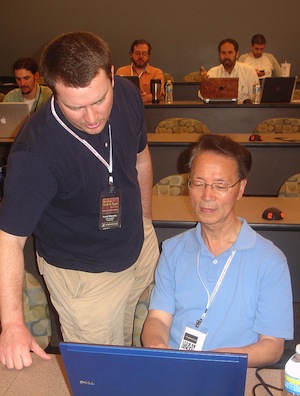Kevin Whinnery Wants You To Run TIE Fighter
Time to read:
This post is part of Twilio’s archive and may contain outdated information. We’re always building something new, so be sure to check out our latest posts for the most up-to-date insights.


Over the course of the next few years, I saved every dollar I could, learned how to take apart a PC tower, diagnose and fix faulty RAM, configure BIOS settings, and learn the basic operation of DOS. Finally, one day, I squared up and disintegrated my first X-Wing fighter. As much fun as that was, it turned out I enjoyed the process of tinkering and experimentation just as much as the end product. I started off trying to get a game running, but what I really discovered was an interest in technology and a desire to understand how stuff worked. After my marginally successful foray into hardware, I decided to try my hand at writing the kind of software I struggled so hard to get running.
In my first programming class, I teamed up with a few of my classmates to write a multiplayer RPG around a classic schoolyard combat game in Scheme. While sales of Red Rover 2002 were ultimately disappointing (no doubt due to the lack of a curated app store for distribution), that process of collaboration and creating something from nothing was incredibly fun and rewarding. These positive early experiences with software development eventually led me to a career writing code, at first for a large ERP software vendor in my home town of Saint Paul, MN.
From Developer to Evangelist
As a developer, the thrill of exploration and creation is what gets me out of bed in the morning. Luckily, with the speed at which the tech world moves along, there’s never a shortage of opportunity for experimentation. Though anytime you run an experiment, you’re never 100% sure what the end result is going to be. I saw this manifested in my own career when my on-the-side involvement with a small open source project from Appcelerator turned into a full time job, much of which was in the role of a developer evangelist. An “evangelist” was not something I ever imagined I would be, but it turns out that it is the best job ever. Every day, I get to help smart people execute awesome hacks to solve real problems. I get to share their passion and become a tiny part of their success, which is a joy and privilege I can’t adequately describe. I am tremendously grateful to be a developer evangelist once again for Twilio.
Launching More “TIE Fighters”

After four years with Appcelerator, our developer community launched tens of thousands of mobile apps into the wild and breathed life into our open source projects. I got to train developers at large corporations. I worked through the night with teams of talented designers and hackers on 24 hour projects. I got to meet entrepreneurs who launched new businesses because our community and technology opened doors that were previously closed to them. Smartphones are proving to be an incredible canvas for technical creativity.
Appcelerator helped more people pick up a paintbrush by opening up native platform capabilities in a cross-platform framework for JavaScript developers. Twilio is enabling developers in a similar way to work on an even bigger canvas – the global telecommunications network. The Twilio platform has opened up the black box of telecom with simple web APIs that allow developers to command traditional phones, SMS text messages, and VoIP clients as easily as they can position a DOM element with CSS. This has already contributed to the creation of great experiences by the likes of Intuit, eBay, Uber, and Hulu. But as I look around at what people in the community are working on, allowing the digital world to reach further into the real world – it’s clear that we’ve only scratched the surface of what’s possible. I can’t wait to help developers explore this new frontier, even if it’s just to play around. I think we’ll find that experimentation can lead to rewards well beyond anyone’s expectation.
Whatever your TIE Fighter is, I’m here to help you get it running.
Related Posts
Related Resources
Twilio Docs
From APIs to SDKs to sample apps
API reference documentation, SDKs, helper libraries, quickstarts, and tutorials for your language and platform.
Resource Center
The latest ebooks, industry reports, and webinars
Learn from customer engagement experts to improve your own communication.
Ahoy
Twilio's developer community hub
Best practices, code samples, and inspiration to build communications and digital engagement experiences.